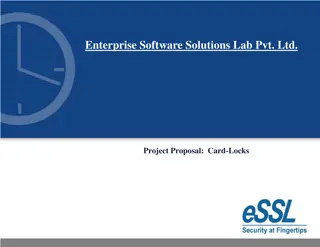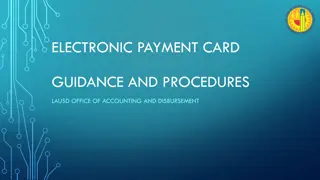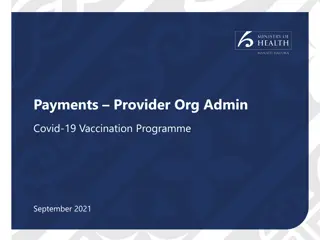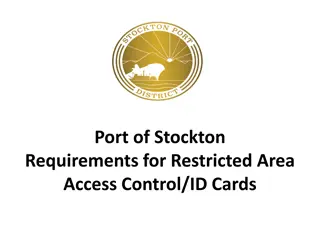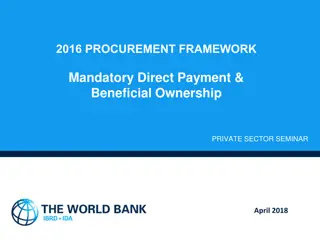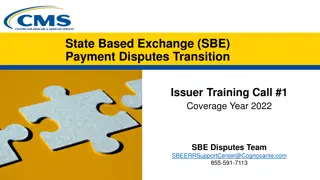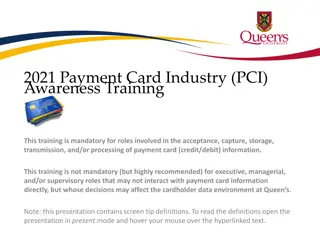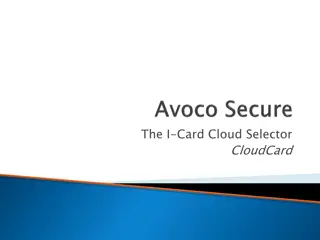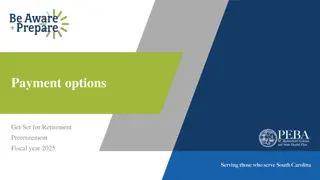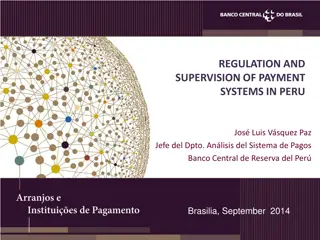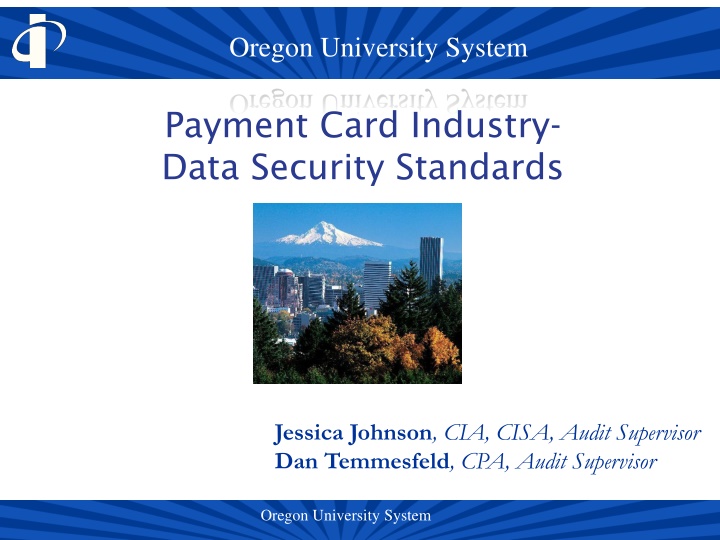
Oregon University System Payment Card Industry Data Security Standards Overview
Explore the Payment Card Industry Data Security Standards (PCI DSS) overview as it pertains to the Oregon University System, covering compliance requirements, common risks, and internal controls. Learn about the importance of PCI DSS in safeguarding cardholder information and preventing data breaches.
Uploaded on | 0 Views
Download Presentation

Please find below an Image/Link to download the presentation.
The content on the website is provided AS IS for your information and personal use only. It may not be sold, licensed, or shared on other websites without obtaining consent from the author. If you encounter any issues during the download, it is possible that the publisher has removed the file from their server.
You are allowed to download the files provided on this website for personal or commercial use, subject to the condition that they are used lawfully. All files are the property of their respective owners.
The content on the website is provided AS IS for your information and personal use only. It may not be sold, licensed, or shared on other websites without obtaining consent from the author.
E N D
Presentation Transcript
Oregon University System Payment Card Industry- Data Security Standards Jessica Johnson, CIA, CISA, Audit Supervisor Dan Temmesfeld, CPA, Audit Supervisor Oregon University System
Agenda PCI DSS Overview PCI DSS Trends in Compliance 2011 Data on Data Breaches Internal Audits Role Common Risks and Internal Controls State of Oregon Approach Oregon University System 2
PCI DSS Overview PCI DSS: Payment Card Industry Data Security Standard 2.0: sets out requirements to help those accepting card payments to protect cardholder information: Assess Remediate Report Compliance is mandatory if you store, process or handle credit or debit card information. Oregon University System 3
PCI DSS Overview Compliance is self-monitored within the industry Must validate compliance by providing info to bank: Self-Assessment Questionnaire (SAQ), or Report on Compliance (ROC), generally for larger organizations Quarterly network scans showing no breaches Failure to comply could lead to PCI brands/banks removing your right to accept cards as methods of payment Oregon University System 4
PCI DSS Overview Who does PCI DSS affect? Business Affairs Office Bursar/Cashier Campus Bookstore (if owned/operated by the university) Any network segment that has a system that stores, processes or transmits confidential PCI data Point of Sale retailers on campus? Decentralized department that sells tickets to events? Selling of other materials outside of normal BAO/Cashier collections? Oregon University System 5
PCI DSS Overview The Scope of PCI DSS Workstations Servers Wireless and wired networks Mobile payment processing including remote POS devices and smartphones Cloud computing A big no no hardcopy files or storing full credit card #s in Excel Oregon University System 6
PCI DSS Overview Why is PCI DSS important? Helps set the bar for compliance and controls that could save organization from a critical data breach! A few Horror Stories!! 1. Heartland Payment Systems 100 million accounts 2. TJ Maxx 94 million customer records 3. Sony Playstation 77 million names, addresses, C/C 4. Morgan Stanley 34k investment clients on CDRom 5. IBM employee data fell off a truck Current cost estimates $100 to $300/record Source: various financial news sources and the 2011 Ponemon Institute Report Oregon University System 7
PCI DSS Trends in Compliance Compliant vs. non-compliant (2009-2010) Approx 64% of compliant organizations reported suffering no data breaches involving credit card data over the past two years. Only 38% of organizations which were not compliant reported no breaches during 2009 & 2010 Cyber-criminals target smaller organizations, less likely to have implemented basic security measures, or to have done so incorrectly. Source: 2011 Verizon DBI Report, 2011 Ponemon Institute Report Oregon University System 8
PCI DSS Trends in Compliance Compliant organizations suffer fewer data breaches Duh! 64% compliant vs. 38% non-compliant organizations 26% of non-compliant organizations suffered more than five breaches over two years This seems obvious, but Source: 2011 Ponemon Institute Report Oregon University System 9
PCI DSS Trends in Compliance Perception of compliance is cynical 670 U.S. & multinational IT security practitioners While the majority of compliant organizations suffer fewer or no breaches, most practitioners still do not perceive PCI-DSS compliance to have a positive impact on data security 88% didn t agree that PCI regulations had an impact Only 39% considered improved security as one of the benefits Source: 2011 Ponemon Institute Report Oregon University System 10
PCI DSS Trends in Compliance Despite the cynicism of CIOs & IT practitioners, compliance is increasing: 2009 Ponemon Institute Report: 1/2 had some compliance 1/4 hadn t achieved any compliance 2011 Ponemon Institute Report: 2/3 had some compliance Only 16% hadn t achieved any compliance Oregon University System 11
2011 Data on Data Breaches Analysis of 7 years, 1700+ breaches, and over 900 million compromised records Source: 2011 Verizon Data Breach Investigations Report Oregon University System 12
2011 Data on Data Breaches Source: 2011 Verizon Data Breach Investigations Report Oregon University System 13
Internal Audits Role PCI DSS: A Tool for Internal Auditors Framework to measure effectiveness of which customer information is secured Regulatory argument for mitigating risks Oregon University System 14
Internal Audits Role PCI DSS: A Job for Internal Auditors Identify gaps in compliance Support creation and implementation of a security program to fill gaps Help management prioritize corrective action Offer advice and support Outstanding gaps Issues with requirement interpretation Oregon University System 15
Internal Audits Role Steps for Internal Audit Department Evaluate During Annual Risk Assessment Relation to IT Security and Compliance Determine Appropriate Approach and Incorporate into Annual Audit Plan Formal Audit vs. Consulting Engagement In-house vs. External Consultant Competency Considerations Opportunities for Collaboration State Treasury Department Oregon University System 16
Internal Audits Role Audit Analysis Data Flow Input, Processing, Output, and Storage Business Requirements Compliance Feasibility Gaps Prioritization by Impact Solutions Collaboration with Management & External Partners Oregon University System 17
Common Risks & Internal Controls The overall risk is DATA BREACH Reputation Legal issues Lost revenues, increased costs, administrative headaches $$$$$$$ estimated $100 to $300/record breached Oregon University System 18
Common Risks & Internal Controls Overall risk is data breach, brought on by: Open-ended access (physical & logical) Vulnerability decentralization hardware or software poor policies and procedures Insufficient monitoring & training Oregon University System 19
Common Risks & Internal Controls Implement strong access controls Risk: Open-ended access / inadequate access controls leaves PCI data wide-open Restrict access to those who need it as part of their job, specific User IDs per user (not just generic or shared AR Clerk ) Logical: robust, mandatory change passwords Physical: locked servers, keycard entry, limit access to those that need to as part of job Oregon University System 20
Common Risks & Internal Controls Build and maintain a secure network Risk: Vulnerability with decentralized operations or unknown interaction Network logical access controls firewall robust passwords Network Segregation PCI computers vs. non-PCI Establish policies for non-Business Affairs PCI collections (mandatory adherence) Oregon University System 21
Common Risks & Internal Controls Protect cardholder data Risks: Outdated or incomplete policies and procedures Old, vulnerable hardware Manual forms Establish & carryout policy to protect & encrypt when transmitting data Keep up-to-date on hardware maintenance Do away with manual record storage Oregon University System 22
Common Risks & Internal Controls Vulnerability management Risk: Old, vulnerable software Keep up-to-date on virus protection software Establish periodic software maintenance plan Oregon University System 23
Common Risks & Internal Controls Monitor, monitor, monitor Risk: Insufficient monitoring and lack of proper training Maintain an IT security policy IT function, test physical & logical access, maintenance of anti-virus & patches Great controls don t matter if they aren t implemented as designed. Monitoring needs to be a key function of management. Oregon University System 24
State of Oregon Approach Oregon State Government merchant card usage (total merchant card revenue) 2000 - $125,000,000 2010 - $572,000,000 Oregon University System 25
State of Oregon Approach State Agencies Responsibility for Securing Sensitive Banking Information PCI DSS National Automated Clearinghouse Association (NACHA) Rules Oregon University System 26
State of Oregon Approach Oregon State Treasury s (OST) Role Ensure state agencies can demonstrate their diligence in protecting the merchant card information entrusted to them. Three OST staff are assigned to provide assistance with securing sensitive banking information. Oregon University System 27
State of Oregon Approach OST Compliance Program: 2008-2009 Discovery/Education PCI/ACH Surveys (Excel) Based on Self Assessment Questionnaires (SAQs) published by the PCI Modified PCI Standards for ACH transactions. Results Verbally Communicated Oregon University System 28
State of Oregon Approach OST Compliance Program: 2010-2011 New Technology/Education Rapid SAQ Web-based Requirement Specificity Information Library Evidence Storage Results Summarized at a State-wide Level Full Compliance Expected, Not Enforced Oregon University System 29
State of Oregon Approach OST Compliance Program: 2012 Continue educating and assisting Focus on compliance gaps already identified Increased enforcement In depth review of supporting documentation Non-compliant agencies need to show corrective action plan Revocation of merchant ID needed to process transactions only for extreme non-compliance Oregon University System 30
State of Oregon Approach OUS IAD Collaboration Consulting Role Direct institutions to OST when setting up new credit card functions Available to help with policy development Resource for questions Oregon University System 31
State of Oregon Approach OST Recommendations Strong Tone From the Top Use Cross Functional Teams Simplify Security Requirements Similar Control Structure for Data with Similar Risks and Values Focus on Improving Key Compliance Gaps Already Identified Oregon University System 32
Useful Resources Oregon University System 33
Oregon University System Questions ? Oregon University System


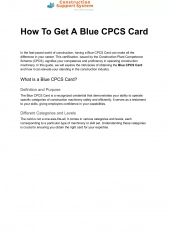
![Guardians of Collection Enhancing Your Trading Card Experience with the Explorer Sleeve Bundle [4-pack]](/thumb/3698/guardians-of-collection-enhancing-your-trading-card-experience-with-the-explorer-sleeve-bundle-4-pack.jpg)
